|
 |
|
 |
|
| After David killed Goliath the Philistine
giant, David became a man on the run. He
collected other men who were wanted,
fugitives, bandits, on the margins of
society. Twice when Saul came to kill David,
David spared his monarch's life. And Saul
blessed David. But David realized that once
the troubled king had a change of heart,
David would once again be a marked man. |
|
|
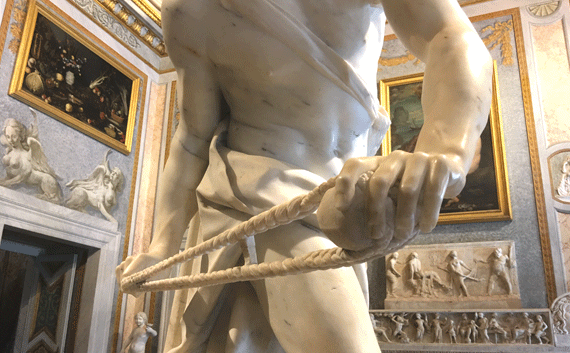 |
|
Sculpture
by Bernini in Galleria Borghese, Rome |
Photo by Gila Yudkin |
|
David about to kill Goliath the Philistine giant in the Valley
of Elah |
|
| So David fled to the Philistine capital city
of Gath (Goliath's home town) and appealed
to King Achish for sanctuary. Not only for
himself, but for his band of six hundred
outlaws and his two wives, Ahinoam of
Jezreel and Abigail the Carmelite. David
asked Achish to give him a place "in the
country" where he could settle down. |
|
| So Achish gave him the town of Ziklag, along
the southern boundary of the Philistine
territory. This became David's base from
where he launched his brutal raids against
the neighboring Geshurites, Amalekites and
other non-Israelite peoples. After killing
all the residents, man, woman and child, he
took sheep, cattle, oxen, donkeys, camels,
and chihuahuas (just kidding) as booty. He
divvied it up and gave King Achish his fair
"commission." |
|
|
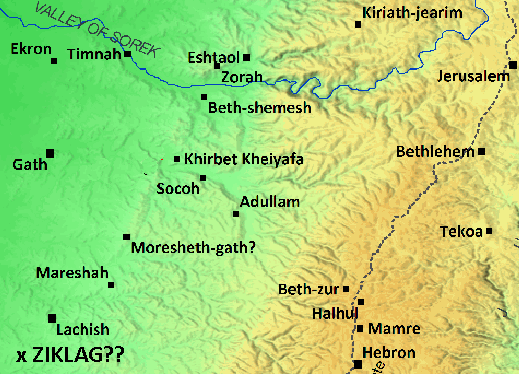 |
|
Copyright
2020 by Gila Yudkin |
|
Scholars believe
Ziklag was on the periphery of Philistine
territory near Judah |
|
| But David claimed to the Philistine king
that all this loot came from the Israelite
settlements he had raided. (Remember, there
were no eye witness victims of David's
plunder to say otherwise.) Thus David lured
Achish into thinking that his attacks would
make his fellow Judean countrymen abhor him. |
|
| In the meantime King Saul was in a standoff
with the Philistine army over control of the
Jezreel Valley with its lucrative trade
routes. When Saul realized his channel
to the Almighty was blocked (like having no
cell service!), he sought an alternative
medium and secretly visited the
witch of En Dor. She conjured Samuel the Prophet up from the
dead who then pointed a long crooked finger
at Saul and proclaimed, "Tomorrow you and
your sons will be with me!" And so it was. |
|
| Did you ever wonder where David was during
this decisive battle? Why he didn't come to
the rescue of Saul and Jonathon, his best
buddy? |
|
| Well, according to First Samuel chapter 29,
David and his men had accompanied King
Achish of Gath to the gathering point of the
Philistine armies at Aphek (basically where
the control tower of Ben Gurion Airport is
today). But the Philistine princes upon
seeing David and his forces objected,
asking, "What are these Hebrews doing
here??" |
|
| The Philistine princes rightly suspected
that David might act as a fifth column and
turn on them in the midst of battle. In this
way he could once again regain his favored
position in Saul's household. |
|
| While professing his trust in David's
loyalty, the Philistine king of
Gath caved
in to his allies and sent David and his 600
men back to Ziklag. That meant when Saul,
along with three of his sons including
Jonathon, died on Mount Gilboa, David was
some 118 miles to the south of the fateful
battlefield. |
|
| In fact when David returned to Ziklag, he
discovered to his horror that it was
deserted and smoldering from an attack by
the Amalekites. His two wives, Ahinoam and
Abigail, his men's wives and sons and
daughters had all been taken captive. David
pursued the attackers and recovered all…and
more. The spoils he sent off to the elders
of the Judean towns of Bethel, Ramot, Yattir,
Eshtamoa and Hebron. |
|
| It was at Ziklag that David received a
messenger who brought him news of Saul's
tragic death at the hands of the
Philistines. David tore his garments,
grieved and wept and fasted. And at Ziklag
David lamented Saul and Jonathon with the
song of the bow: (Second Samuel chapter 1) |
|
"How have the mighty fallen!
Tell it not in Gath,
Proclaim it not in the streets of Ashkelon –
Lest the daughters of the Philistines
rejoice.
Lest the daughters of the uncircumcised
triumph."
|
| At Ziklag, David inquired of the Lord, where
shall he go. The reply was, "Go to Hebron." So David left Ziklag and went to Hebron. At
Hebron David was anointed king over the
house of Judah. |
|
| We know where Gath is, where Ashkelon is,
where Hebron is, but where is Ziklag??? This
has puzzled Bible scholars for over a
century. |
|
| I researched this question in 1996 while
preparing for a dynamite tour organized
around the theme, "Retracing the stories of
David and his Greater Son Jesus" for a
favorite tour leader. One of the tour's
themes was "David as fugitive." There were a
number of possibilities: En Gedi, Masada,
Carmel, Ziph, Beersheba, Ashkelon -- and
Ziklag. |
|
|
I was attracted to the idea of bringing the
group to Ziklag. After all, David
spent 16 months there, according to the Book
of Samuel. But where was it? I hit the
books and out of a dozen possibilities, the
majority of scholars at that time (23 years
ago) identified Ziklag with Tel A-Shariyah,
some twelve miles northwest of
Beersheba,
halfway between Beersheba and Gaza. |
|
| The name Ziklag, by the way, is unusual in
the lexicon of names in the kingdom of
Israel. It is not local Canaanite, nor
Semitic. It is a Philistine name, given to
the town by an alien population of migrants
from the Aegean region. |
|
| I really had no idea where it was exactly. We didn't have GPS back then or Google maps.
And we hadn't visited that particular tel
during my guide course some two decades
earlier. I read in the encyclopedia "Madrich
Yisrael" volume 6 that Tel A-Shariyah was
near Kibbutz Mishmar HaNegev. So there I
headed. |
|
| Armed with
last century maps, I drove to
the area in my trusty fire-engine red
Fiesta, looking for a beige-colored
artificial mound with straight edges peeking
up above the flat fields of golden wheat. (Not exactly a needle in a haystack.) I
spied a farmer on a tractor and he gave me
directions towards the ancient mound. On
foot now, I crossed the old Turkish RR
tracks and found a path leading up to the
tel. It was spectacularly dusty yet visually
unimpressive although I did find a lot of
potsherds. |
|
| Reluctantly I gave up the idea of bringing
my group to the site – there was no nearby
parking for a bus, it was in the middle of
nowhere and so very dusty. But I was
disappointed – Ziklag epitomizes a unique
chapter in the David saga. |
|
| Imagine then, my surprise this past July
[2019] when headlines in Israeli newspapers blared,
"Ziklag is found!!" And not where they
thought it was…. |
|
| Archeologists (from Israel and Australia)
digging since 2015 at a site called Khirbet
a-Ra'i in the Judean foothills opposite
Ashkelon, between Kiryat Gat and Lachish,
held a well-attended press conference. They
announced they had found a continuous
settlement at Khirbet a-Ra'i with remains
from both the Philistine culture and from
the era of King David with both periods
attested by carbon-14 dating. |
|
|
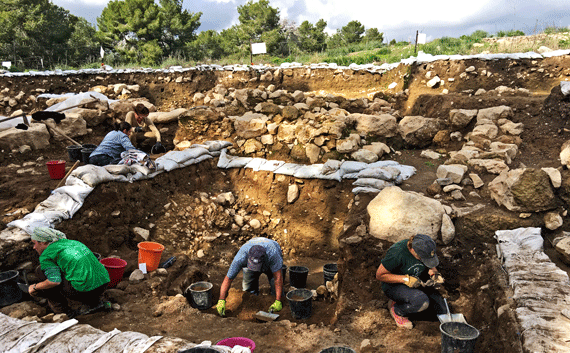 |
|
Photo:
Gila Yudkin |
|
Volunteers from the U.S.
and Australia digging at Khirbet a-Ra'i
January 2020 |
|
| The Philistine strata revealed spacious,
massive stone structures with lots of
typical Philistine decorated ceramic
pottery. In the foundations of the buildings
excavators found bowls and oil lamps which
had been deposited during construction as
offerings for good luck (or to trap demons). They also found stone and metal tools
similar to those found at other Philistine
cities such as Ashkelon, Ashdod, Gath and
Ekron. |
|
| Above the remains of the Philistine
settlement was a rural settlement from the
early tenth century BC, the time of King
David which was destroyed by an intense
fire. (Remember that Ziklag had been blazed
while David was absent to attend the
gathering of Philistine forces at Aphek –
see First Samuel 30:1.) |
|
| Nearly one hundred complete pottery vessels
were found in various rooms from this period
along with many large and medium-sized
storage jars for oil and wine. Jugs and
bowls were found decorated in the
"red-slipped and hand-burnished" style
typical of King David's time. |
|
| There's lots more to say. And lots more to
be uncovered. Come with me to Ziklag where
David spent 16 months. We'll open our Bibles
to First and Second Samuel and Psalms to
study the strange episode of Ziklag,
focusing upon the anointed David as
fugitive, a man on the run. |
|
|
Postscript January 2020 |
|
|
After pining to explore Ziklag for several
months, Gila traveled with a group of guides for an
in-depth tour at Ziklag at the
end of January 2020. Here are her
photos and remarks: |
|
|
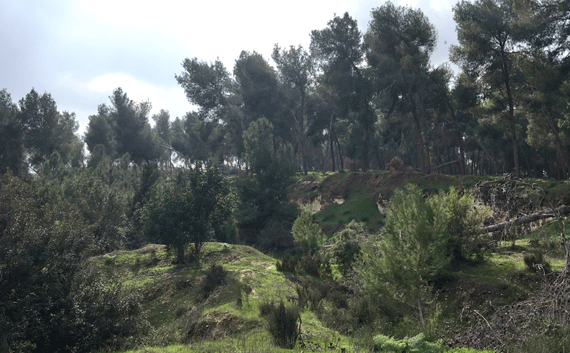 |
|
Photo:
Gila Yudkin |
|
Khirbet a-Ra'i (probably
Biblical Ziklag) is beyond the pine trees on
the summit |
|
|
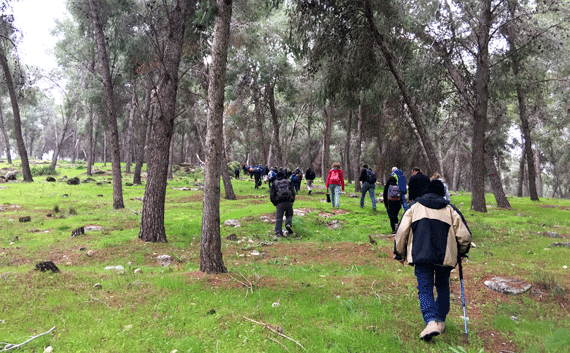 |
|
Photo:
Gila Yudkin |
|
A fifteen minute hike
takes you to the first excavated area at
Khirbet a-Ra'i |
|
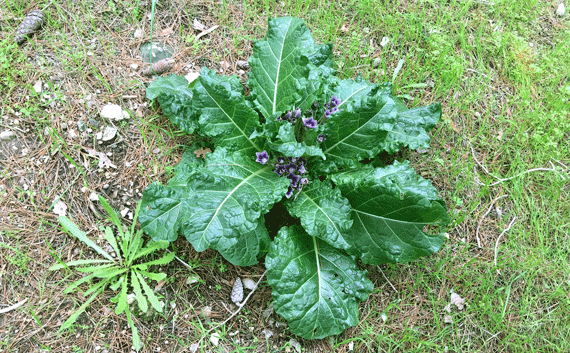 |
|
Photo:
Gila Yudkin |
|
Mandrakes, known to increase fertility, were sought after by both Leah and Rachel! |
|
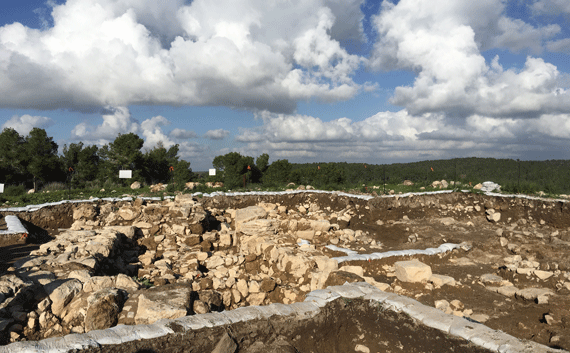 |
|
Photo:
Gila Yudkin |
|
The so-called Philistine
area on the summit of Khirbet a-Ra'i |
|
|
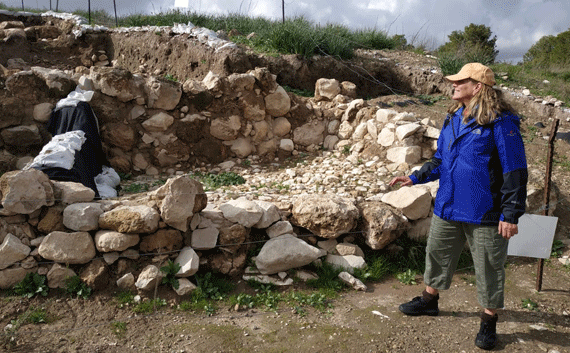 |
|
Photo:
Silvia Hess |
|
To the left of Gila an
area dubbed "King David's pavement"
is dated to
the 10th c BC |
|
|
Postscript in 2021 |
|
|
The excavation team has continued to dig at
Khirbet a-Ra’i (presumably biblical Ziklag). In July of 2021 the
Israel Antiquities Department announced that
an inscription dating from the time of the
biblical judges some 3,100 years ago has been
recovered for the first time in history from
excavations in southern Israel. |
|
|
The rare inscription bears the name "Jerubbaal"
in alphabetic script and dates from around
1,100 BCE. |
|
|
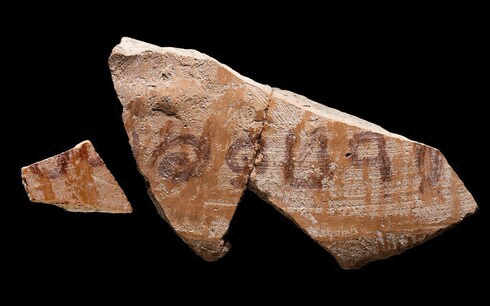 |
|
Courtesy of
the Israel Antiquities Department |
|
Rare inscription with the
name Jerubbaal found at Khirbet a-Ra'i in
July 2021 |
|
|
The inscription was written in ink on a
pottery vessel and found inside a storage
pit that was dug into the ground and lined
with stones at the site at Khirbet a-Ra‘i. |
|
|
The name Jerubbaal is familiar from
the Book of Judges as an alternative name
for the judge Gideon. For example, in
Judges 6:32 after Gideon had fought idolatry
by destroying an altar to Baal, he was
renamed Jerubbaal meaning “let Baal plead
against him, because he has torn down his
altar.” |
|
|
|
Judges 7 tells the story of Gideon’s triumph
over the Midianites who used to cross over
the River Jordan to plunder Israelite crops.
Gideon organized a small strike force of 300
soldiers who attacked the Midianites by
night near the spring of Harod in the
Jezreel Valley in northern Israel.
Judges chapter 7 begins, “Then Jerubbaal
(that is, Gideon) and all the people who
were with him rose early and encamped beside
the spring of Harod, so that the camp of the
Midianites was on the north side of them by
the hill of Moreh in the valley [of
Jezreel].” |
|
|
Scholars believe that the name Jerubbaal was in
common usage at the time of the Biblical
Judges. |
|
|
|
The Khirbet a-Ra’I archeological team is
continuing to dig each summer, so stay tuned
for further discoveries!! |
|
|
Copyright 2020, 2021 Gila Yudkin. Permission
needed for any reuse. |
|
|
Gila
Yudkin, who calls herself a
Connecticut-born Yankee living in King
David's Court, is thrilled to find another elusive biblical
site identified. She has not yet guided a
group at biblical Ziklag although she has
been retracing David's footsteps for forty
years with her groups. Gila revels in
converting black and white Bible verses to
vivid color in 3-D, imprinted upon your
heart. |
|
|
If your heart's desire is to follow the
footsteps of David, organize a tour and
bring your family and friends.
Gila
would be happy to lead you to as many sites
as have been identified till now. Gila's
tours are a mix of archeology, geography,
Bible and fun. Read what
tour
leaders say about Gila. |
|
| After David killed Goliath the Israelites
pursued the Philistines past Shaaraim as far
as Gath and Ekron. (First Samuel 17:52) Several years ago
Shaaraim was
identified by the same archeologists
excavating now at Ziklag. |
|
| Read about the story of
Gath, hometown of
Goliath, with photos (of Gath,
not Goliath!) |
|
|
From Ziklag David moved to
Hebron
and then after seven and a half years to
Jerusalem which he made his capital.
Read about the
bathing beauty David spied
from his palace balcony and the subsequent
cover-up. |
|
|
|
|
For four decades Gila has been reenacting
David's contest with Goliath when visiting
the Elah Valley with her
groups. She even divides the group
into Israelites and Philistines with each
team creating its own war chant.
Book
Gila for your next church tour. |
|
|
Late 19th century explorers Bliss and
Macalister didn't have iPhones for compass
directions, weather reports or breaking
news, but they did identify Philistine
strongholds of
Azekah and
Gath. Read more about them. |
|
|

